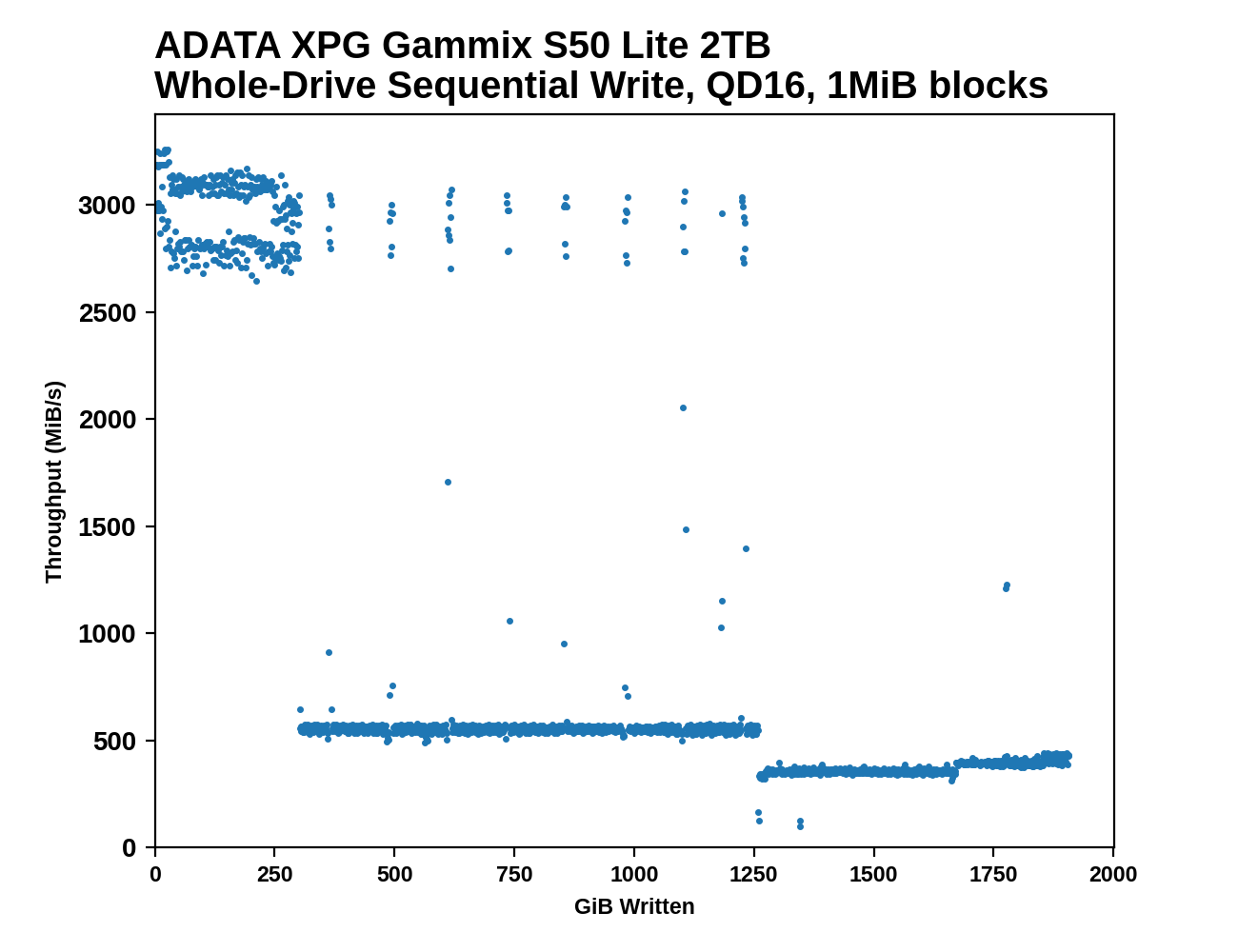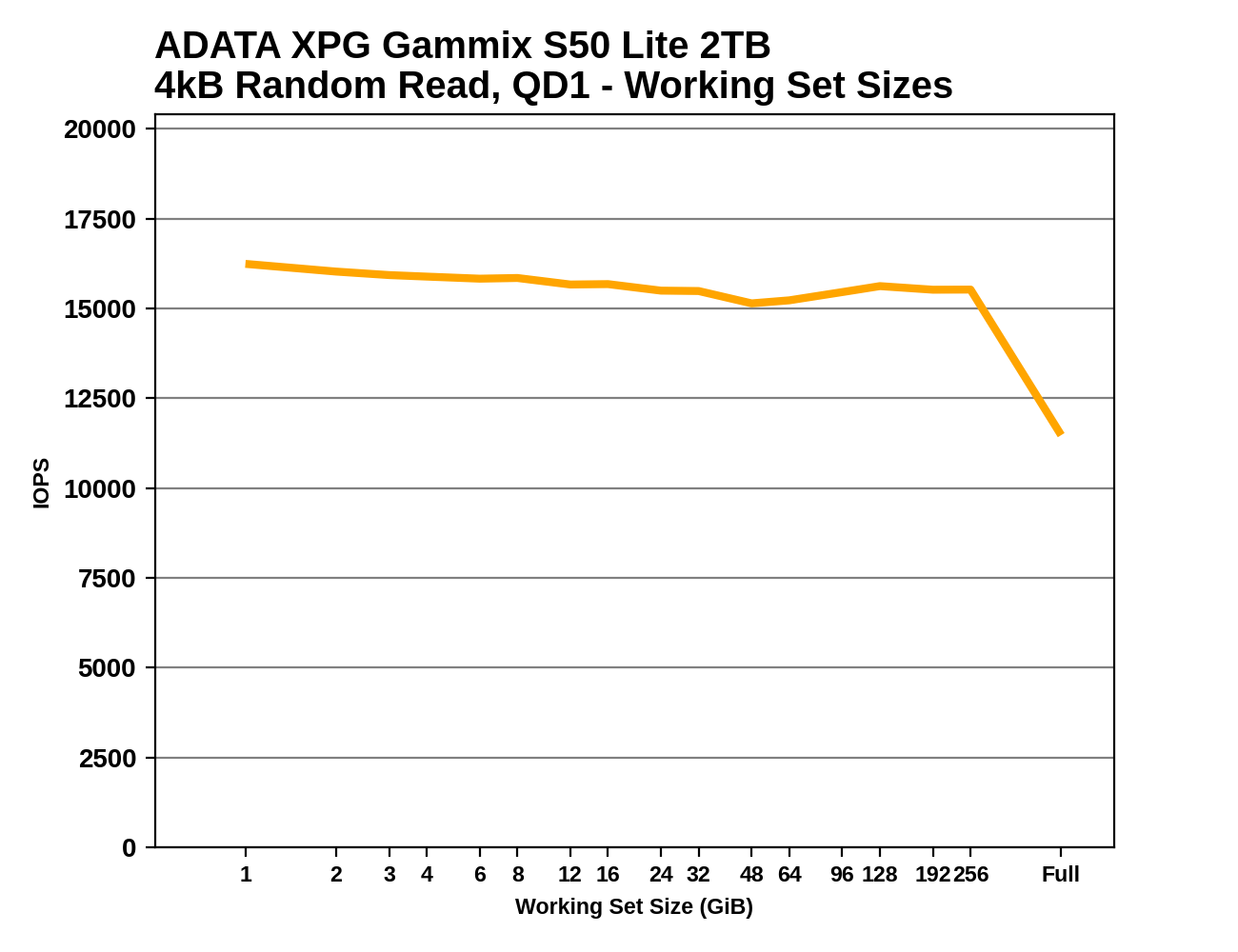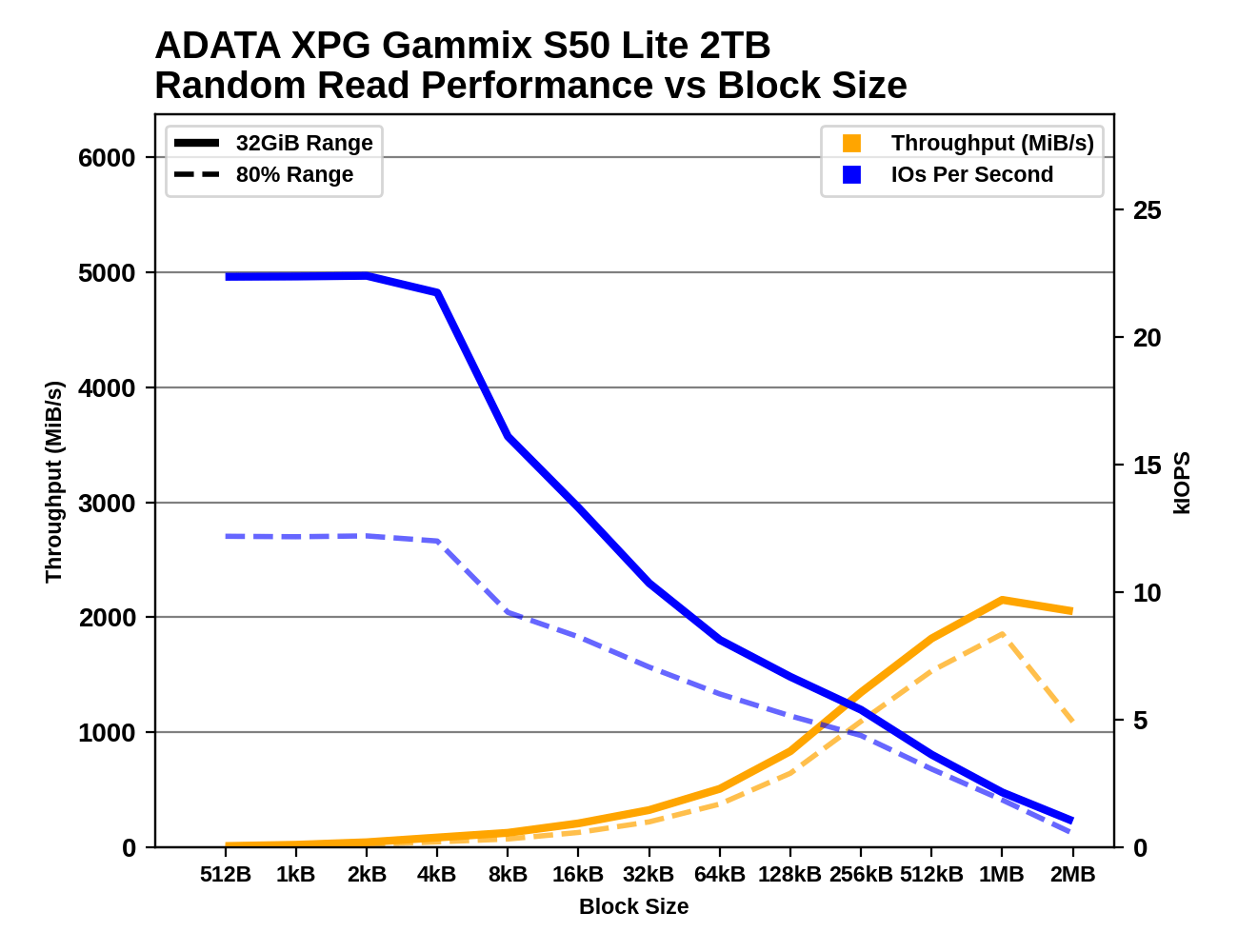The ADATA GAMMIX S50 Lite 2TB SSD Review: Mainstream PCIe Gen4
by Billy Tallis on April 30, 2021 8:00 AM ESTAdvanced Synthetic Tests
Our benchmark suite includes a variety of tests that are less about replicating any real-world IO patterns, and more about exposing the inner workings of a drive with narrowly-focused tests. Many of these tests will show exaggerated differences between drives, and for the most part that should not be taken as a sign that one drive will be drastically faster for real-world usage. These tests are about satisfying curiosity, and are not good measures of overall drive performance. For more details, please see the overview of our 2021 Consumer SSD Benchmark Suite.
Whole-Drive Fill
 |
|||||||||
| Pass 1 | |||||||||
| Pass 2 | |||||||||
The ADATA XPG Gammix S50 Lite shows an almost QLC-like performance drop when the SLC cache runs out after about 300GB: it falls down to SATA speeds. But even though its post-cache write speed is half of what we're used to seeing from TLC drives (most of which use controllers with 8 channels rather than 4), the S50 Lite still has a big lead over the two QLC drives in this bunch.
On the second pass of filling the drive, the S50 Lite's SLC cache is good for only about 14GB and the post-cache performance is much less consistent, with frequent drops below 100MB/s and spikes back up to SLC speeds around 3GB/s.
 |
|||||||||
| Average Throughput for last 16 GB | Overall Average Throughput | ||||||||
Working Set Size
 |
|||||||||
The S50 Lite has excellent random read latency for smaller working sets, beating all but two of the drives in this bunch. But the consequences of having only 1GB of DRAM for a 2TB drive show up at the end of the test, where the random read performance falls off sharply once the reads span the entire drive rather than just a small slice.
Performance vs Block Size
 |
|||||||||
| Random Read | |||||||||
| Random Write | |||||||||
| Sequential Read | |||||||||
| Sequential Write | |||||||||
The S50 Lite offers the same random read IOPS for all the IO block sizes from 512 bytes up to 4kB, but when testing random writes there's a clear preference for 4kB block sizes rather than anything smaller. Rather surprisingly, sequential reads with 4kB block sizes are far slower than for slightly smaller or larger block sizes; it would appear that the drive assumes 4kB reads will be random IO, and skips whatever caching or prefetching is active when using other block sizes.










93 Comments
View All Comments
Oxford Guy - Friday, April 30, 2021 - link
'At least'? QLC is a downgrade, not an upgrade.Scour - Sunday, May 2, 2021 - link
Never wrote that the A400 was upgraded ;)Sorry, I´m not a native english speaking person
Tomatotech - Friday, April 30, 2021 - link
I've run an ADATA XPG SX8200 (non-pro) 1TB for the past 3+ years in my MacBook Pro as the system drive. Been very happy with it, and still blistering fast even now. Was approx 3x faster read & 4x faster write than the Apple OEM SSD, made a big difference to the feel of my MPB.As to changing components, not brilliant, but perhaps inevitable over the life of a long-lived model. Most SSD brands are not full-stack manufacturers, and supply / cost of sub-components is outside their control. As long as it meets the specs on the box and isn't crippled (like silently changing HDD models to HAMR mechanism without stating on the box).
Anandtech was quite accepting of companies changing SSD components on their middle-low end lines in the last SSD roundup. The 8200 Pro launched around 3 years ago, and while it's still damn fast for most people, I'd call it middle of the road now that PCIe 4.0 is here.
Scour - Friday, April 30, 2021 - link
I would prefer a new model-name if other components are used.MrCommunistGen - Friday, April 30, 2021 - link
+1They could easily have done this a number of ways:
1. add a letter to the end of the model with each rev, SX8200A, SX8200B
2. add Mk1, Mk2, etc.
3. increment the model number by +1 every time, SX8201, SX8202, etc
Each of these signify that it's still a related product aimed at the same market segment, while communicating that it isn't the exact same hardware that was reviewed when the product initially came out.
Scour - Sunday, May 2, 2021 - link
I still think the main reason is to use a model name which had good reviews.And maybe it costs 10 cents more/piece if you order new packages with a new model number
Oxford Guy - Friday, April 30, 2021 - link
And yet Intel, which was mentioned on the first page, has been at the forefront of pushing the anti-value QLC trash.Which would you rather choose? A company that is openly hostile to consume value or one that changes parts surreptitiously?
Nvidia is reportedly going to surreptitiously sell some 3060s with its latest anti-mining thing, without bothering to let consumers know which type they're getting for their money. Things like that should be illegal but the world is not governed adequately. Caveat emptor rules. The panel lottery for TVs is a huge example of the surreptitiousness fraud.
bji - Friday, April 30, 2021 - link
Holy crap man, will you get off of your anti-QLC rant already?Oxford Guy - Friday, April 30, 2021 - link
Ad hominem won't change reality. In reality, QLC offers only 30% more density for double the voltage states. That is diminished returns.Moreover, every dollar consumers spend on QLC reduces the price value of TLC by reducing TLC production.
I'm not sorry that I'm ruffling the feathers of various QLC-peddling corporations by posting the truth. Being attacked for it is hardly unexpected. It's how business communication works.
FunBunny2 - Friday, April 30, 2021 - link
"In reality, QLC offers only 30% more density for double the voltage states. That is diminished returns."IFF both TLC and QLC are on the same node size. moving back up to a larger node (and I know not whether that's happened) for QLC could (note the subjunctive) end up with an equivalent NAND density/bit. that, of course, should be the controlling factor.